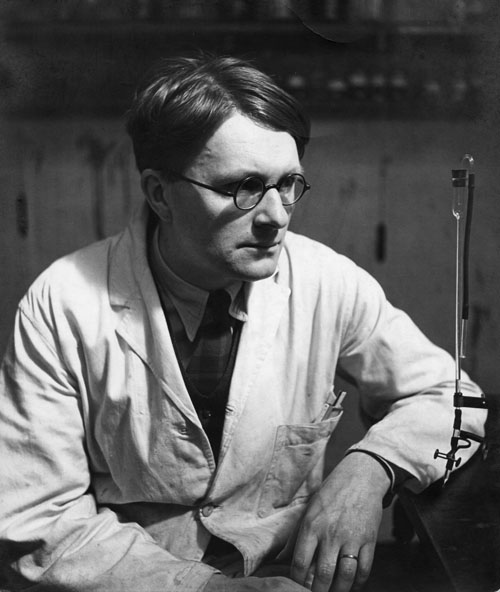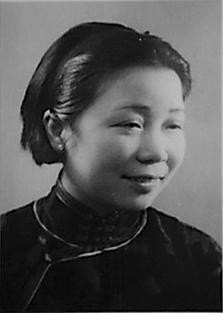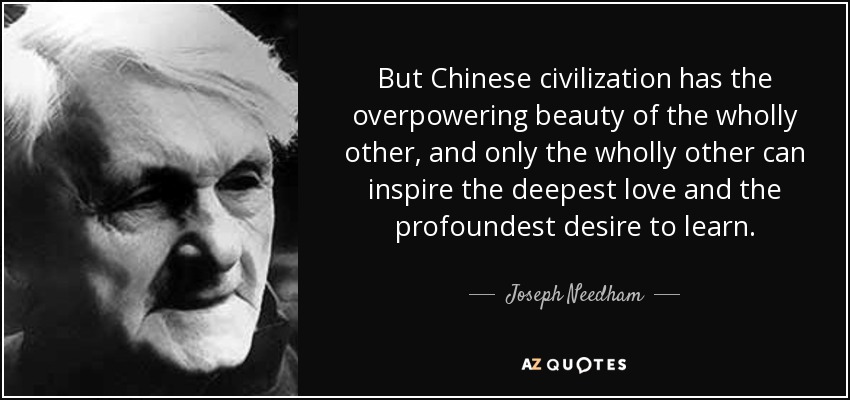
Nearly all Chinese people are familiar with the four great inventions of ancient China: the compass, gunpowder, papermaking and printing. Indeed China is justifiably proud of these great scientific and technological achievements which predated similar advances in the West by hundreds of years. However, it is less well known that ancient and medieval China was responsible for far more technological and scientific developments than these four and it is only in the last few decades that the scale of China’s extraordinary inventiveness has been uncovered. The man most responsible for documenting this immense effort was an English scholar with an adventurous spirit and boundless curiosity — Joseph Needham.
Born in 1900, the young Joseph was sent at the age of 14 to one of England’s most famous schools, Oundle, where he demonstrated a talent for science. He successfully applied to study medicine at Cambridge University, but soon switched to read chemistry, a subject he found much more intellectually satisfying. After obtaining his degree, Needham decided to stay on at Cambridge and do a doctoral degree in the newly established Institute of Biochemistry. Tall and handsome, if somewhat shy and eccentric, Needham soon became a popular member of the research team, specializing in embryology. In September 1924Needham married biologist Dorothy Moyle and the following month became a fellow of Caius College, Cambridge. It appeared his career as an academic scientific researcher fellow was set.

However, Needham’s life changed completely with the arrival in Cambridge in 1937 of a brilliant young Chinese scientist, Lu Gwei-djen. She had rooms just down the corridor from Needham’s and they worked closely together in the autumn of that year. By Christmas they both realized that they had fallen head over heels in love with each other. Needham’s wife, Dorothy, was aware of the situation but accepted it without complaint. It was Lu who first sparked Needham’s interest in all things Chinese and was his first Chinese language teacher. He was an excellent student and an avid learner (he could speak five other languages already) and by the time war broke out in Europe in 1939 Needham could not only speak Chinese fluently but could write Chinese characters with some degree of competence. Needham soon became recognized as an expert on China and he volunteered for war work to support Chinese science in the face of Japanese aggression. After a few months of negotiation Needham arrived in China for the first time in February 1943 and made it to Chongqing in March. His life’s work was about to begin.

Even before reaching China Needham had already begun to discuss with Gwei-djen why it was that science in general in China had not continued to develop after its early glories. He was determined to learn all he could about Chinese science. During his stay in Chongqing, and on his eleven research trips to other parts of China, Needham made numerous discoveries about Chinese science. He learnt that the first printed book in China had been produced was in 865 AD, 600 years before the first printed book in the West, Gutenberg’s Bible. He found out that the Chinese invention of papermaking included wrapping paper (second century BC), toilet paper in 589 AD and paper money in the ninth century AD. No one in the West and not many people in China were aware of these innovations. Needham was a true pioneer.
On his return to Cambridge after the war and a brief stint with the United Nations in Paris, Needham set about planning his masterpiece. In May 1948 he sent a proposal to Cambridge University Press outlining his plan to write a single volume about China concerning “the history of science, scientific thought and technology in relation to the general history of civilization, and especially the comparative development of Asia and Europe” to be entitled “Science and Civilization in China.” The press readily accepted Needham’s 60 proposal but within a few weeks he had radically revised the scale of the work. He now estimated that it would take seven volumes to cover all the topics in his proposal and complete the work.
Needham assembled a team of Chinese and Western scholars and got to work. The first volume of Science and Civilization in China (SCC) was not published until 1954, by which time it was clear that the estimate of seven books was wildly inaccurate. The work was enormous and seemingly never-ending. By the time of Needham’s death in 1995 at the age of 94, seventeen books of SCC had been published, of which seven had been written or co-written by Needham himself. After his death a further seven books have appeared bringing the total to twenty-four, and the project is ongoing. The breadth of the work is staggering, covering over twenty-five centuries of Chinese work in scientific areas as diverse as agriculture, astronomy, botany, chemistry, geology, engineering, maritime navigation, mathematics, medicine, military technology, physics, textiles and zoology. Between 2580 BC when silk was first spun in China, until the early sixteenth century Chinese creativity produced some extraordinary inventions including the abacus, ball bearings, cast iron, firecrackers, kites, ladders, porcelain, the waterwheel, and the wheelbarrow, to name just a few.
Needham’s initial question, known today as the “Needham question” about why science did not continue to develop in China after around 1500 AD, and scientific progress instead transferred to the West, continued to bother him and remains something of a puzzle. There are a number of varied but interconnected reasons. One is that China lacked a free market with property rights and so inventors were not rewarded for their work. Moreover, the lack of competition in the market led to a lack of experimentation. Another reason is that imperial rule in China consisted of a mass of bureaucratic regulations and demanded adherence to custom, tradition and routine; innovation was neither required nor encouraged. Others emphasize the larger values of society and the fact that women, who made up much of the labour force in the industrializing societies in the West, were confined to the home in China. Whatever reason ultimately holds sway, it is clear that China today is experiencing once again an explosion of creativity, inventiveness and energy. The 500-year period during which China stopped innovating in science and technology may be seen in retrospect as a brief interlude of unusual quiet among the more common activity of this great civilization.
Needham was truly a man who loved China and he did more than anyone to bring the hidden wonders of Chinese science and technology to light and to the wider world.



